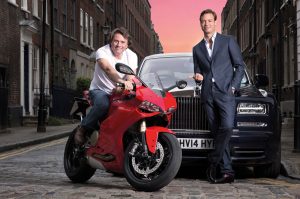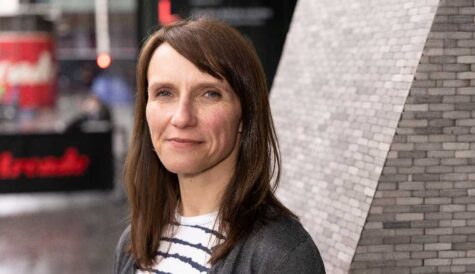Have content will travel
 Travel shows, with their beautiful backdrops and larger-than-life locals, may seem like a no-brainer for broadcasters, but they increasingly need a twist if they are to attract the attention of programme buyers, reports Andy Fry
Travel shows, with their beautiful backdrops and larger-than-life locals, may seem like a no-brainer for broadcasters, but they increasingly need a twist if they are to attract the attention of programme buyers, reports Andy Fry
“As with any other genre, travel shows need strong stories and characters if they are going to appeal to buyers,” says Nicky Davies-Williams, CEO of DCD Rights. “If you don’t have celebrities, unique access or some kind of added editorial elements, your show won’t engage viewers and appeal to buyers, especially if you are expecting it to play in primetime.”
For the DCD distribution boss, this explains the rise of the travel-hybrid, exemplified by DCD’s A Cook Abroad, which aired on BBC Two in the UK. “This is a show where six famous cooks take us on a culinary tour of the world’s most inspiring food cultures. They travel to different countries to track down the origins of their favourite dishes. In doing so, they get under the skin of cultures.”
 Another DCD show, The Billion Pound Hotel (left), gives viewers unique access to Dubai’s spectacular seven star hotel, the Burj Al Arab. “Here, the appeal is looking behind the scenes at a place most of us will never visit,” says Davies-Williams. “Some people may be tempted to go to Dubai after seeing the show, but it also works as an aspirational armchair travel experience.”
Another DCD show, The Billion Pound Hotel (left), gives viewers unique access to Dubai’s spectacular seven star hotel, the Burj Al Arab. “Here, the appeal is looking behind the scenes at a place most of us will never visit,” says Davies-Williams. “Some people may be tempted to go to Dubai after seeing the show, but it also works as an aspirational armchair travel experience.”
Most execs agree with the notion that travel can’t just be the TV equivalent of your brother-in-law’s holiday slide show. “There is still some room for the classic travelogue,” says Tricon Films executive VP distribution and business development Jon Rutherford, “but the last five years has seen a definite blurring of the lines between travel and reality TV. More and more we’re seeing stories around travel lifestyle, airports, hotels, baggage and food, so it’s important to reflect that in your content slate.”
Tricon’s current titles include Off the Map with Shannen & Holly (below), a travel reality series in which Charmed co-stars Shannen Doherty and Holly Marie Combs go on a girls’ road trip through the southeastern US. There’s also Extreme Collectors, in which antiques appraiser Andrew Zegers travels across North America on a televised treasure hunt to find amazing collections people have amassed.
![]() “There are elements of the classic travel show in both, but there are so many TV and online channels giving you travel tips, that you don’t need a travel show to do that anymore,” Rutherford says. “You can focus on the story and characters and then use a second screen if you want to know more.”
“There are elements of the classic travel show in both, but there are so many TV and online channels giving you travel tips, that you don’t need a travel show to do that anymore,” Rutherford says. “You can focus on the story and characters and then use a second screen if you want to know more.”
Hat Trick International’s sales chief Sarah Tong says: “Travel show producers have to realise they are up against established TV brands that often carry their own travel elements. If you think about a Top Gear special to Patagonia or Africa or the Middle East, then that is a kind of travel show embedded inside a powerful factual entertainment franchise.”
HTI’s slate includes Exploring China, in which Ken Hom and Ching-He Huang go on a culinary journey; Bangkok Airport (top), an access-driven ob-doc that looks at travellers going in and out of the Thai airport; and Billionaire’s Paradise: Inside Necker Island. The latter, like DCD’s Dubai show, is a look behind the scenes at one of the world’s most exclusive destinations. HTI also represents Scandimania, a another hybrid travel show in which celebrity chef Hugh Fearnley-Whittingstall asks why Sweden, Norway and Denmark are seen as the happiest countries in the world. “It works well because he has such a strong fanbase worldwide; this kind of show is in demand from buyers,” says Tong. “But my one warning is that you need to be careful about how you present hybrids. Some channels have quite rigid slot structures and you can find that they won’t take a show because its subject-matter falls between two stools.”
While celebrities are often vital to the success of a travel show, it’s not enough for them to just turn up and take the air. Themes that crop up repeatedly during discussion with distributors are the need for authenticity and the sense that the celebrity is on a personal journey. For example, Michael Palin’s combination of intelligence, sensitivity and subtle humour made him the David Attenborough of the genre.
FremantleMedia International director of non-scripted Angela Neillis says her company’s travel slate deploys famous faces in a range of scenarios. “One show we launched at MIPCOM was Dara and Ed’s Great Big Adventure, which sees comedians Dara O’Briain and Ed Byrne travelling along the Pan-American Highway. You get beautiful locations, history, interaction with local characters and great repartee between two friends.”
FMI’s catalogue also includes various Jamie Oliver food/travel hybrids; Railway Journeys, fronted by former politician Michael Portillo; and Nigel Marven’s Cruise Ship Adventures, which employs an interesting structure. In the show, animal expert/adventurer Marven voyages on a luxury cruise liner, jumping off at each port to meet the locals, and taking passengers with him: “We’ve always done well with shows involving Nigel, but the twist here is that he is on a cruise ship, trying to find adventures in the limited time the ship is in port,” says Neillis.
Railways and cruise ships inevitably appeal to an older demo, but a change of host and a different set of experiences can soon have your show skewing younger, says Chris Bonney, CEO Rights at Cineflix Media. “We have a title called Food, Booze and Tattoos, which follows a model called Brett Rogers as he travels through some of South Africa’s less well-known contemporary sub-cultures. It’s not a typical travel show because it focuses on really cool places to eat, micro-breweries, edgy tattoo parlours.”
 Like his peers, Bonney says travel shows “need to be multi-layered, so that travel is a character in the show and not the sole subject”. Like Tricon and FMI, he is interested in shows where two hosts can play off against each other. “In Road Rivals, we have polar opposites in Russ Malkin and Charley Speed,” he says. “Russ travelled the world with Ewan McGregor on the Long Way Round and Long Way Down, and is used to harsh terrains and sleeping in rough, remote locations. Charley is a Next Top Model judge and was VH1 Vogue’s Male Model of the Year. Throughout the series, they force each other to try the other’s preferred style of travel, so you get a really interesting competitive dynamic to it.”
Like his peers, Bonney says travel shows “need to be multi-layered, so that travel is a character in the show and not the sole subject”. Like Tricon and FMI, he is interested in shows where two hosts can play off against each other. “In Road Rivals, we have polar opposites in Russ Malkin and Charley Speed,” he says. “Russ travelled the world with Ewan McGregor on the Long Way Round and Long Way Down, and is used to harsh terrains and sleeping in rough, remote locations. Charley is a Next Top Model judge and was VH1 Vogue’s Male Model of the Year. Throughout the series, they force each other to try the other’s preferred style of travel, so you get a really interesting competitive dynamic to it.”
Passion Distribution has had a lot of success with food/travel hybrid Man vs Food and An Idiot Abroad, a comedy travelogue in which Karl Pilkington brilliantly subverts the genre with his unique brand of wry wit.
For Passion Distribution CEO Sally Miles, one emerging trend is the way travel has embraced the formatted approach that works so well in other factual sub-genres. “We have a show in our slate called Baggage Battles, which follows auction specialists as they travel the world bidding on unclaimed and lost property,” she says. “Aired on the Travel Channel, it’s one of those great shows like Pawn Stars and Storage Wars where there is a process in every episode that viewers become familiar with and return to.”
 There’s also been a trend towards adventure travel, says Miles, though even here the emphasis is still on engaging stories. “We have Firecracker Films’ Air Pressure (right), which follows young British pilots whose job is to fly and land planes in remote, dangerous parts of Indonesia. You follow the story of their career development, mixed with amazing scenery and their contact with indigenous peoples.”
There’s also been a trend towards adventure travel, says Miles, though even here the emphasis is still on engaging stories. “We have Firecracker Films’ Air Pressure (right), which follows young British pilots whose job is to fly and land planes in remote, dangerous parts of Indonesia. You follow the story of their career development, mixed with amazing scenery and their contact with indigenous peoples.”
Other extreme travel shows that employ clear narrative goals include Travel Channel’s Expedition Unknown, in which Josh Gates investigates iconic mysteries such as the disappearance of Amelia Earhart’s plane. Similar in style is Discovery Networks International’s Ed Stafford Trailblazer. In this series, explorer Stafford, who is famed for walking the Amazon and appearing in the nude of Naked and Marooned, sets out to discover the truth behind mysterious satellite images of Earth’s most remote locations.
Beyond Distribution is another company with a broad slate of travel shows. “We have quite a few where the intention has been to build up a strand such as Anh Does Brazil and Anh Does Italy as well as My France With Manu,” says head of sales Munia Kanna-Konsek. “The Holiday Show is pure fun holiday destinations, while one of our feature launches at MIPCOM was Boy to Man, an adventure travel series which takes the viewer on an epic quest to discover what it means to become a man.”
Kanna-Konsek likes the genre because it is possible to produce travel shows with the kind of co-viewing appeal that provides schedulers with flexibility. “The pan-satellite channels such as Discovery and Scripps’ Food and Travel networks are good homes, but our other big buyers are free-to-air networks, cable and satellite channels, VOD platforms and DVD – any territory where we can window,” she says.
In terms of trends, Kanna-Konsek says “everyone is always looking for the next new thing and I believe these genres are cyclical. First it could be adventure travel, then food travel then a combination of both, then observational. Celebrities can give you the edge but now we are also seeing a good deal of programmes where viewer material, using their GoPro footage, is included. Also, food/travel hybrids like World’s Weirdest Restaurants, Chuck’s Week Off: Mexico, and BBQ Crawl do well for us”.
While many of the shows above are targeted at primetime, Off The Fence managing director, distribution Bo Stehmeier says more traditional long-running travel series can play a key role in access or shoulder prime. “The right travel series can do a great job for broadcasters that need a strong access primetime, but don’t have budgets for local production,” he says. “Depending on the channel profile you can go for a series that skews young male, more adrenalin-adventure focused, or young female, more shopping-luxury focused, and then look for an airline or tourism sponsor to offset the cost of the acquisition.”
Travel also works well for broadcasters that are running a single feed to multiple destinations, says Stehmeier. “These channels need to constantly prove to subscribers they are relevant to keep them engaged,” he says, “so travel shows with a mix of cultures and destinations work well. We have established series like the 50x60mins Travel Bug and 40x30mins Raw Travel, which have volume, a spread of destinations and skew young. New titles in our slate include Wonders of…, Finding Little Italy and Rock the Park, which taps into America’s love affair with its national parks.”
Another sub-set of travel that Stehmeier points out is the kind of high-end show that “platforms can use to show off their HD or 4K capabilities. We have an HD show called Aerial America that captures this beautifully. This is often a very gentle, serene kind of programming, but it can play out nicely in the background on some factual channels”.
Travel is then one of those genres where it is possible to forge close links between content and brands, so it is timely to observe that global hotel/hospitality firm Marriott International has been named as MIPTV 2015’s Brand of the Year in recognition of its global content studio, which is working with producers to develop a content marketing strategy based around travel.
One of its first projects is the short film Two Bellmen, a collaboration with dance, martial arts and music collective Substance Over Hype, which features the JW Marriott Los Angeles L.A. LIVE hotel as a character in the film. Underlining the fact that the travel genre is no longer just about what features on TV screens, Marriott has also signed deals with various YouTube stars in the sector. The aim, says David Beebe, VP, creative and content marketing, global marketing, is “to become the leading publisher of travel lifestyle content that engages travellers and builds Marriott’s reputation as the world’s favourite travel company.”
Beebe’s is no stranger to TV, having held key digital posts ats Fishbowl Worldwide and ABC.
One of the YouTubers signed up by Marriott is Jack Harries, an online success story who underlines the fact that TV travel shows need to pay attention to what’s happening in digital.
Harries launched YouTube channel JacksGap in 2011 to chart his gap year experience. Today, the channel – which now involves his brother Finn – has close to four million subscribers. The vast majority are teenage girls, reinforcing the idea that the TV’s endless efforts to attract young viewers will probably soon involve the poaching of YouTube talent to front TV programming.
Buyers briefing: Travel Channel
 Scripps Networks Interactive’s Travel Channel has about 450 hours of new content coming down the pipe each year, says Ross Babbit, the US cable network’s senior VP programming.
Scripps Networks Interactive’s Travel Channel has about 450 hours of new content coming down the pipe each year, says Ross Babbit, the US cable network’s senior VP programming.
“The DNA of all our shows is great storytelling and characters. Shows like Booze Traveler with Jack Maxwell and Bizarre Foods with Andrew Zimmern have the kind of authenticity that audiences love because they are based around incredibly passionate people.”
Editorially, the channel seeks to celebrate world culture, but it is not shy of tackling tough issues, says Babbit. “We’ve just premiered Breaking Borders, a show that travels to places that have a history of conflict and gets people from opposite sides to share a meal and conversation. Where we probably do differ from other factual channels is that we would stop short of the more salacious travel shows.”
In term of trends, he points to adventure series like Expedition Unknown and says he is happy to include some advertiser-funded programmes in the schedule. “We did World’s Best Bartender with Diageo, which worked well, but identifying quality programming has to be the priority,” he says.



